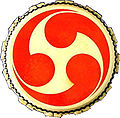- Tomoe
-
A tomoe or tomoye (archaic) (巴) is a Japanese abstract shape (a swirl) that resembles a comma or the usual form of magatama. It is a common design element in Japanese family emblems (家紋 kamon) and corporate logos, particularly in triplicate whorls known as mitsudomoe (三つ巴). Some view the mitsudomoe as representative of the threefold division (Man, Earth, and Sky) at the heart of the Shinto religion. Originally, it was associated with the Shinto war deity Hachiman, and through that was adopted by the samurai as their traditional symbol. One mitsudomoe variant, the Hidari Gomon, is the traditional symbol of Okinawa. The Koyasan Shingon sect of Buddhism uses the Hidari Gomon as a visual representation of the cycle of life.
The tomoe is very similar in design to the Korean sam-taegeuk, Tibetan Gankyil or Chinese yin-yang / taijitu symbols.
On the opposite side of Eurasia, the Basque lauburu and some forms of the Celtic spiral triskele resemble small groups of tomoe.
-
A mitsudomoe design on a taiko drum
-
The Ryūkyū Kingdom flag had a mitsudomoe on it
-
The flag of Jeju has a non-Japanese tomoe
See also
References
External links
Categories:- Visual motifs
- Japanese heraldry
- Japanese art stubs
- Decorative arts stubs
- Heraldry stubs
-
Wikimedia Foundation. 2010.





